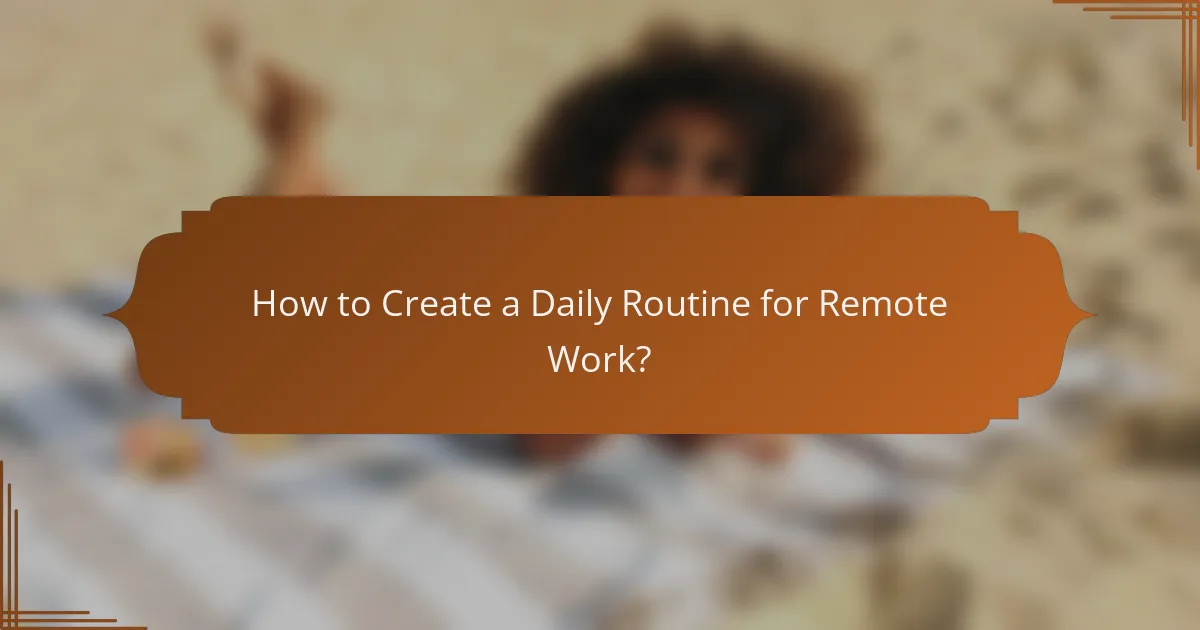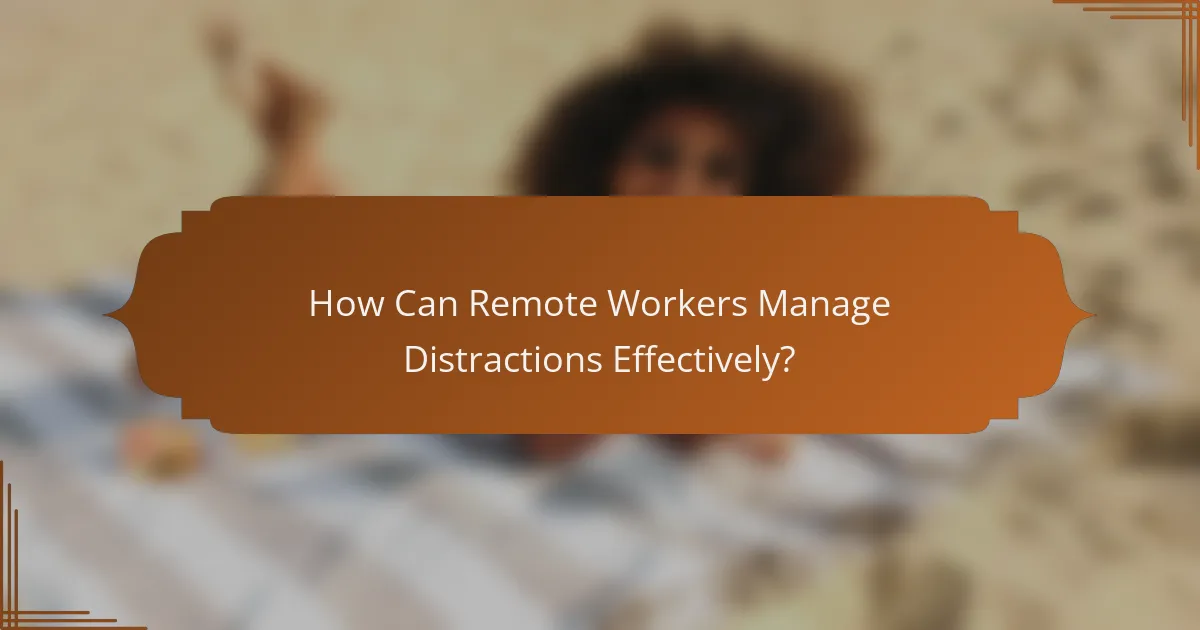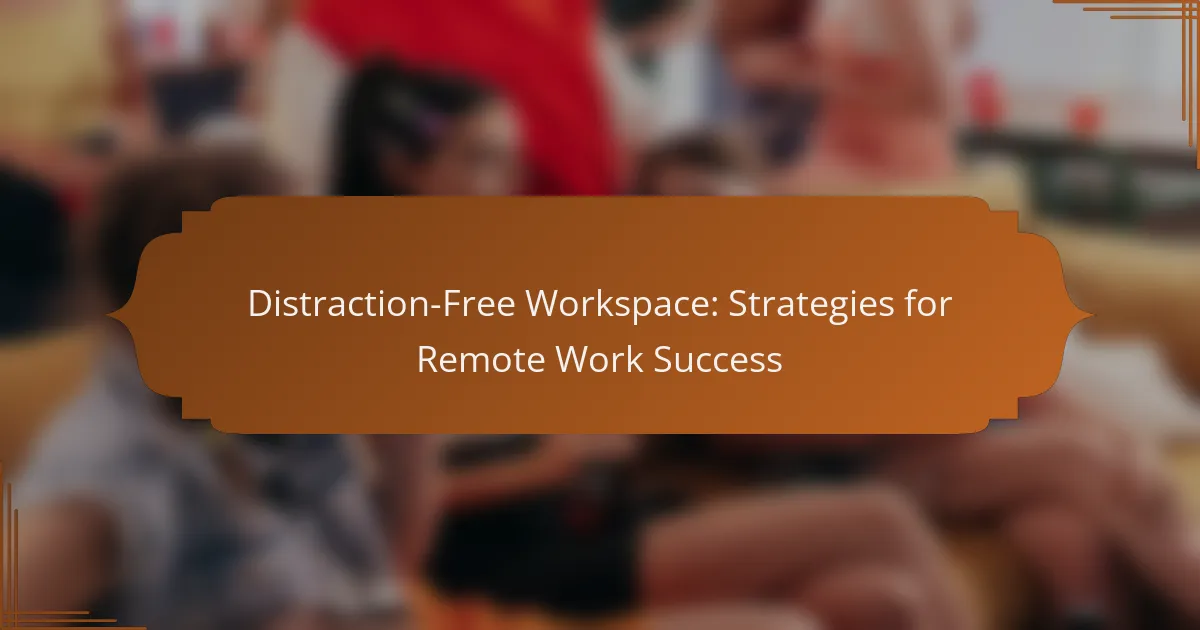Creating a distraction-free workspace is essential for remote work success, as it helps minimize interruptions and boost productivity. By implementing effective strategies and utilizing technology, remote workers can enhance their focus and efficiency while maintaining a structured environment. Additionally, prioritizing ergonomics in workspace design can lead to greater comfort, further supporting sustained concentration and performance.

What Are Effective Strategies for a Distraction-Free Workspace?
Effective strategies for creating a distraction-free workspace focus on minimizing interruptions and enhancing productivity. By implementing specific techniques and maintaining a structured environment, remote workers can significantly improve their focus and efficiency.
Establishing a Dedicated Workspace
Creating a dedicated workspace is essential for maintaining focus while working remotely. Designate a specific area in your home solely for work, which helps signal to your brain that it’s time to concentrate. This space should be comfortable, well-lit, and equipped with all necessary tools.
Consider using a desk or table that is separate from your personal spaces. This physical separation can help reduce distractions and improve your work-life balance.
Implementing Time Management Techniques
Time management techniques, such as the Pomodoro Technique, can enhance productivity by breaking work into manageable intervals. For instance, work for 25 minutes, then take a 5-minute break to recharge. This method helps maintain focus and prevents burnout.
Additionally, prioritize tasks using a simple to-do list or digital tools like Trello or Asana. This keeps you organized and focused on what matters most each day.
Utilizing Noise-Canceling Headphones
Noise-canceling headphones can significantly reduce auditory distractions in a home environment. They help block out background noise, allowing you to concentrate better on your tasks. Look for models that are comfortable for long wear and provide effective sound isolation.
Listening to instrumental music or white noise can further enhance focus. Experiment with different sounds to find what works best for you.
Setting Clear Boundaries with Household Members
Establishing clear boundaries with household members is crucial for minimizing interruptions. Communicate your work hours and the importance of your focus during these times. Use visual cues, like a “do not disturb” sign, to reinforce these boundaries.
Encourage family members to respect your workspace and schedule. This mutual understanding fosters a more productive environment for everyone involved.
Incorporating Minimalist Design Principles
Applying minimalist design principles to your workspace can help reduce distractions and enhance focus. Keep your desk clutter-free by only displaying essential items. A clean and organized space promotes a clear mind.
Choose a simple color palette and limit decorative items to a few meaningful pieces. This approach not only creates a calming atmosphere but also minimizes visual distractions that can disrupt your workflow.

How Can Technology Enhance Focus in Remote Work?
Technology can significantly enhance focus in remote work by providing tools that minimize distractions and streamline task management. By leveraging various applications and software, remote workers can create an environment conducive to productivity and efficiency.
Using Focus Apps like Forest
Focus apps such as Forest help users stay concentrated by gamifying the process of maintaining focus. When you want to concentrate, you plant a virtual tree that grows as long as you avoid distractions. If you leave the app, the tree dies, encouraging commitment to your work.
These apps often include features like timers and reminders, which can help structure your work sessions. Consider setting specific time blocks, such as 25 minutes of focused work followed by a 5-minute break, to maximize productivity.
Leveraging Task Management Tools like Trello
Task management tools like Trello allow remote workers to organize tasks visually, making it easier to track progress and prioritize work. Users can create boards for different projects, add cards for individual tasks, and move them through various stages of completion.
Utilizing such tools can help prevent overwhelm by breaking down larger projects into manageable tasks. Regularly reviewing and updating your boards can keep you aligned with deadlines and goals, ensuring that nothing falls through the cracks.
Employing Website Blockers like Freedom
Website blockers like Freedom can help maintain focus by restricting access to distracting websites during work hours. By selecting specific sites to block, you can create a tailored environment that minimizes interruptions from social media or news sites.
Consider scheduling block sessions during your peak productivity hours. This can help you establish a routine that reinforces focus and reduces the temptation to browse distracting content. Remember to communicate your work hours to others to minimize interruptions during these focused periods.

What Role Does Ergonomics Play in Productivity?
Ergonomics significantly impacts productivity by enhancing comfort and reducing strain during work. A well-designed workspace minimizes discomfort, which can lead to improved focus and efficiency over time.
Choosing an Ergonomic Chair
Selecting an ergonomic chair is crucial for maintaining good posture and comfort while working. Look for features such as adjustable seat height, lumbar support, and armrests to accommodate your body type and preferences.
Consider chairs that allow for a range of adjustments, enabling you to find the most supportive position. A chair that promotes a neutral spine position can help prevent back pain and fatigue during long hours of work.
Setting Up an Adjustable Desk
An adjustable desk allows you to alternate between sitting and standing, which can enhance comfort and reduce the risk of musculoskeletal issues. Aim for a desk that can be easily adjusted to your preferred height, typically between 28 to 48 inches for standing use.
When setting up your desk, ensure that your elbows are at a 90-degree angle when typing, and your wrists are straight. This setup helps maintain a natural posture and can prevent repetitive strain injuries.
Arranging Monitors for Optimal Viewing
Proper monitor arrangement is essential for reducing eye strain and neck discomfort. Position your monitor at eye level, about an arm’s length away, to keep your neck in a neutral position.
Consider using multiple monitors if your work requires it, but ensure they are aligned to minimize head movement. The top of the screen should be at or just below eye level, allowing you to look slightly down while working.

How to Create a Daily Routine for Remote Work?
Creating a daily routine for remote work involves establishing consistent habits that enhance productivity and focus. A well-structured routine helps minimize distractions and promotes a healthier work-life balance.
Establishing a Morning Ritual
A morning ritual sets the tone for your day and can significantly impact your productivity. Consider incorporating activities such as exercise, meditation, or a healthy breakfast to energize yourself before work.
Try to start your day at the same time each morning to create a sense of stability. This could include setting aside 30 minutes for personal development or planning your tasks for the day ahead.
Scheduling Breaks for Mental Clarity
Regular breaks are essential for maintaining mental clarity and preventing burnout. Aim to take short breaks every hour, lasting about 5-10 minutes, to stretch, hydrate, or step outside for fresh air.
Consider using techniques like the Pomodoro Technique, which involves working for 25 minutes followed by a 5-minute break. This method can enhance focus and improve overall productivity.
Defining Work Hours for Consistency
Defining clear work hours helps establish boundaries between professional and personal time. Choose specific start and end times for your workday to create a routine that others can respect.
Communicate your work hours to colleagues and family members to minimize interruptions. Sticking to these hours can improve your focus and help you manage your time more effectively.

What Are the Best Practices for Remote Team Communication?
Effective remote team communication relies on clear, consistent methods that foster collaboration and connection. Utilizing the right tools and strategies can significantly enhance productivity and team cohesion.
Utilizing Video Conferencing Tools like Zoom
Video conferencing tools, such as Zoom, are essential for remote teams to maintain face-to-face interactions. These platforms allow for real-time communication, helping to convey tone and body language that text-based messages often miss.
When using video conferencing, ensure that all team members have access to a stable internet connection and the necessary hardware. Schedule regular meetings to keep everyone aligned, and consider using features like screen sharing to enhance discussions.
Implementing Regular Check-Ins
Regular check-ins are crucial for maintaining team engagement and accountability. These can be daily or weekly meetings where team members discuss progress, challenges, and upcoming tasks.
Keep check-ins brief, ideally lasting no more than 30 minutes, to respect everyone’s time. Use this time to celebrate small wins and address any roadblocks, ensuring that all team members feel heard and supported.
Encouraging Open Feedback Channels
Creating an environment where team members feel comfortable providing feedback is vital for continuous improvement. Open feedback channels can include anonymous surveys, suggestion boxes, or regular feedback sessions.
Encourage constructive criticism and ensure that all feedback is taken seriously. This practice not only improves team dynamics but also fosters a culture of transparency and trust, which is essential for remote work success.

How Can Remote Workers Manage Distractions Effectively?
Remote workers can manage distractions by creating a structured environment and implementing strategies tailored to their personal needs. Identifying what specifically distracts you and establishing boundaries can significantly enhance focus and productivity.
Identifying Personal Distraction Triggers
Understanding your personal distraction triggers is the first step in managing them effectively. Common triggers include noise, digital notifications, and even household chores. Take note of when you lose focus and what external factors contribute to it.
Once you identify these triggers, you can develop strategies to minimize their impact. For example, if noise is a distraction, consider using noise-canceling headphones or creating a designated quiet workspace. If digital notifications disrupt your workflow, turn off non-essential alerts during work hours.
Regularly reassess your triggers as they may change over time. Keeping a distraction journal can help you track patterns and adjust your strategies accordingly, ensuring a more productive remote work experience.
